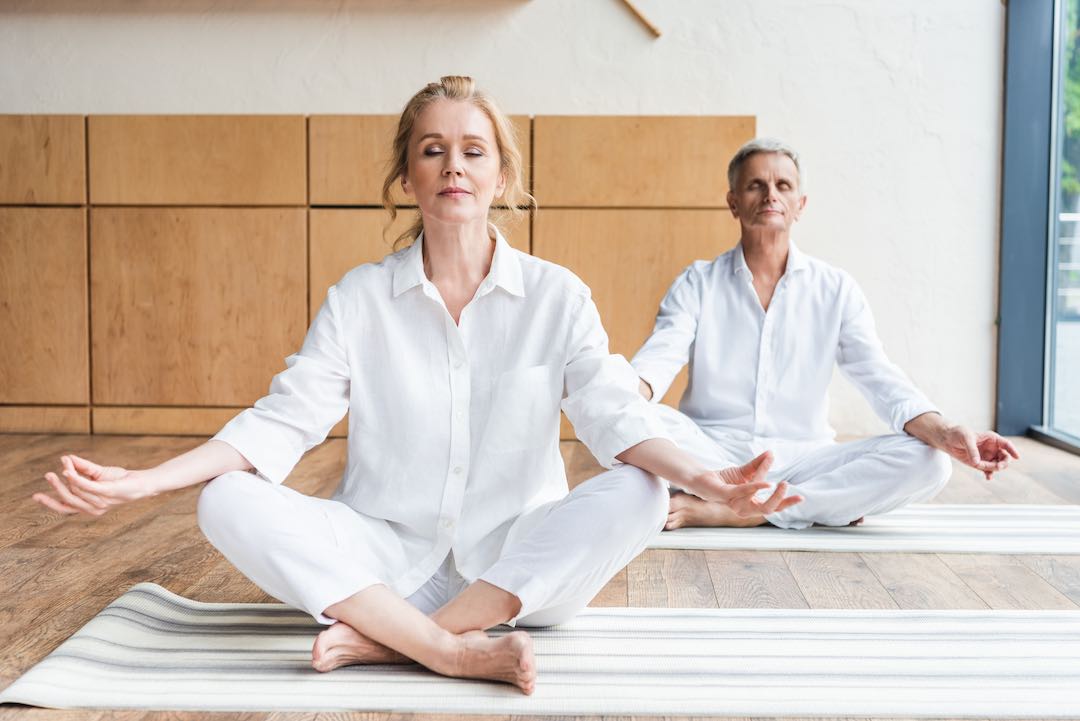You’ve lit the incense, turned on the Tibetan bowl gong CD, crossed as much of your legs as you can for your version of a full lotus. You tried to focus on your breathing, anticipating a blissful, relaxing meditation session, where you activate your third eye and become the enlightened soul you always suspected you were. It’s time to try one of those meditation techniques you’ve heard about in the past…the ones that will help you center yourself, regenerate the body, and help you thrive.
But your mind hopped to what color you’ll paint the kitchen or then reminded you to pay the power bill and why does your nose seem to itch only when you try to meditate? Then the neighbor’s poodle starts barking. Incessantly. Are we having fun yet?
It’s Never Too Late To Begin
Chances are, if you’re reading this at 50+, you’re curious about how to raise your thrive quotient through meditation. You’ve read about celebrities — from the Beatles to Oprah – who have practiced meditation. Maybe you’ve tried to meditate, meeting with limited success. Or maybe you fight with unrealistic expectations about how to practice or develop a routine. Maybe you don’t know where to start. Or maybe you think at this point in your life, why bother?
It turns out the benefits of practicing meditation are real and accessible to each of us…immediately. In this blog, we take a look at some of the benefits of meditation, compare the two primary approaches, offer tips for a simple place to begin and — for those of you wanting to take the next step — provide information about formal training.
Before we look at how to, let’s look at the case for meditation.
Sitting With Benefits
The facts are indisputable, backed by literally hundreds of studies and several thousand years of human experience. Hindus practiced meditation as early as 1500 BCE, Taoists and Buddhists since the 6th and 5th centuries BCE. In the 12th century, the term meditation was applied to the practice of contemplation by the Carthusian monk, Guigo II.
Though the practice of meditation has religious roots, even fifteen minutes a day of meditation (2x is even better) works wonders for our minds and bodies, regardless of spiritual orientation.
Here are a few reasons to consider devoting time to your meditation practice. Even if you don’t unleash your enlightened side.
Within the first five to ten minutes of meditation, a body experiences —
- Lowered heart rate, blood pressure, and blood cortisol levels
- Lessened feelings of stress and anxiety
- Slower breathing rate
Over time the practice of meditation —
- Improves a person’s ability to relax
- Improves quality of sleep
- Raises a feeling of well-being
Why? For more on the nuts and bolts on the physiology of meditation, check out Scientific American, or works by Dr. Joe Dispenza or Jon Kabat-Zinn, each of which has done extensive research on the body’s response to meditation.
Don’t I Need A Mantra?
There are many different paths to the mountain top and different approaches to meditation, from simple mindfulness techniques to advanced practices performed by monks and spiritual aspirants. Regardless of technique, the body’s physiological response to slowing down our thoughts is similar. At a minimum, blood pressure and heart rate lower, inducing a more relaxed state of being.
Meditation practices can be divided into two main forms: one where you focus on something, say breathing, an object, or a personal mantra, as with Transcendental Meditation. The other techniques involve allowing your mind to flow, to be open, to not restrict or judge your thoughts, but rather simply notice them and let them go.
Either practice is beneficial to your health and wellbeing; it’s really a matter of personal preference, finding what works for you and setting aside the time and space to make it happen.
Beginner’s Mind
Whether attempting meditation for the first time or re-visiting the practice, you would be well-served to remember that it’s called a practice for a reason. Some “sits” will go better than others. In some sessions time will vanish, others may seem endless. But if you can approach meditation with what Zen Master Shunryu Suzuki called “Beginner’s Mind” — an openness to possibility — you are more likely to feel its benefits.
Preparing to Meditate
In addition to holding no expectations, there are simple things you can do to prepare yourself physically and mentally to increase the likelihood of a meditation session that revives you.
- Establish a time when you will be less likely to be interrupted. Stow your cell phone.
- Wear comfortable clothes that allow you to breathe freely.
- Turn off any unnecessary lights. Eyeshades work well to block out excess light.
- Set a timer for five minutes to ten minutes
- Sit in a chair with your feet on the floor, or if you are able, sit cross-legged on the floor. The key here is to sit comfortably with your spine erect. If sitting is not an option, lying on the floor with your head and neck supported is fine.
- Close your eyes. Take a full breath in and gently release.
- Focus on your breath. Breathe in, breathe out, following your body’s natural rhythm.
- If you find your mind wandering, don’t worry. Simply return your focus to breathing.
It really is that simple. And that difficult.
At first, five minutes may seem like an eternity. Don’t worry. Try it again the next day. And again. Work your way up to 15 – 20 minutes. At some point in your practice, it may feel like you are coming home to yourself.
An important thing to remember is to hold no rigid expectations about the outcome of your meditation sessions. It is enough to show up and breathe. Your body will do the rest. Holding ultra-high expectations for how often to meditate and how it “should” go or when you will achieve “enlightenment” is added stress and defeats the purpose of simply being in contemplation.
More Tips For Sits
If you feel uncomfortable attempting to meditate on your own, there are countless recordings of guided meditations where a leader will prompt you with phrases or suggestions intended to bring you to a relaxed state, help you release worry, or visualize abundance. As with so many things, finding the right guide is a matter of personal preference. If you don’t like the sound of the leader’s voice, move on to the next option.
Meditating to music, sounds of ocean waves, rainfall, or moving water helps some people tune out distracting sounds. NOTE: if you find yourself falling asleep, that can be a good thing. It shows you have reached a deep level of relaxation. Which, after all, is one of the benefits we are after.
But What About That Mantra?
Some people’s experience of meditation works best for them if they repeat a phrase in their minds over and over. The phrase is referred to as a “mantra”. In the Hindu tradition, this repetition is called “japa,” loosely translated as muttering. Focusing on a word or phrase liberates the mind from overthinking, stress, being in what is called “Monkey Mind” …jumping from one idea to the next. By repeating a sacred phrase over and over, the mind brings forward insights that may be lost in the chatter of your day-to-day.
Almost any phrase that has meaning for you will work, though all major religions have sacred sayings used as mantras. Here are a few examples: the Christian Lord have mercy, Buddhist Om mani padme hum, the Jewish prayer Modeh Ani, Hindu Gayatri Mantra. Again, personal preference plays a role; what is important is to allow repetition of the mantra to calm your mind. Deepak Chopra recommends repeating “so – hum” in your mind along with your breathing. “So” on the inhale and “hum” on the exhale, a vocalization of the universe being breathed into being.
Transcendental Meditation (TM)
By https://www.flickr.com/photos/ogimogi/ – https://www.flickr.com/photos/ogimogi/284517677/, CC BY 2.0, Link
Remember when the Beatles went to India to be with their guru Maharishi Mahesh Yogi? That was a defining moment in the West as far as a mass introduction to meditation is concerned. The form of meditation they learned from the Maharishi started in India in the mid-1950s and became the movement/business known as Transcendental Meditation. It’s estimated that today, over 5 million people worldwide practice this form of meditation.
Transcendental Meditation is a mantra-based practice that requires learning a seven-step program from a certified teacher. The student receives a mantra that is unique to her or him. They then use this mantra for two, twenty-minute sessions per day. Transcendental Meditation, though springing from Hindu roots, is non-denominational and considered a non-religion religion by many.
To practice Transcendental Meditation requires locating a center near you, paying a fee, learning the seven-step program from a certified practitioner, receiving your personal mantra, and beginning the practice, at first under the guidance of your teacher. Mantras are considered sacred, unique to the individual and as such are not to be shared with anyone. The practice is similar to repeating a sacred phrase, with the primary difference being the mantra is chosen specifically for you.
Begin
The health and wellness benefits of meditation are significant compared to the investment of time and effort. You, too, can improve your mental and physical wellbeing, simply by being present to your breathing, fifteen minutes a day. Painting the kitchen can wait. And, who knows? The color may come to you.
Craig is cofounder of Memoir Tours, a 10-day memoir writing retreat in County Mayo, Ireland. When not in Ireland, he lives in Mill Creek, WA and works behind the page as a ghostwriter, content creator, and copy editor. Music, mandolin and guitar, artisan bread and walks along the creek with his granddaughter rank high on his favorite things list. www.memoirtours.com You can reach Craig via: craig@memoirtours.com











